Today, I want to talk about the idea of free parking, a rather bad habit that a lot of American cities have gotten into. Actually, it is worse than that — the American precedent has been imitated worldwide.
Parking consumes valuable land area, which could be used for other things like buildings, parks and squares — in other words, Places For People. Plus, it is ugly. But, probably some parking is necessary. All of this is easily handled by the free market: when the return on capital for parking is greater than for other uses, capital for land and construction will be spent on parking, and parking will be built. Every suburban retailer knows very well how much parking they need.
In general, I hold to the principle of no onstreet parking; and also, no free or subsidized offstreet parking. The first principle is more important. But, the time may come when a city finds that the (typically high-value downtown) land that is used for free or subsidized municipal parking would be better used for some other use, such as an apartment or office building, or even a market-rate multilevel parking structure.
The principle of no onstreet parking applies mostly to situations where a) there is a higher-value use of the space; b) new construction. Quite a lot of low-density suburbia today has already been built out with extra-wide streets designed for onstreet parking, and for which there is no obvious higher-value use. This can be left in-situ; that is, onstreet parking allowed as it has always been. Oddly enough, onstreet parking makes most sense where there is little need for it–where the onstreet parking provided is not used very much, as in a typical low-density single-family detached residential suburb. Typically, most houses have offstreet parking for several vehicles, including enough space for the occasional visitors. A two-car garage, with driveway adequate for two cars to park offstreet, provides space for offstreet parking for four cars. That’s a lot already.
So, we are really limiting our discussion mostly to more urbanized areas, and also, areas where land values are higher, and there is an impetus to redevelop with higher density, for example, replacing single-family houses with apartment buildings, or replacing superfluous offstreet parking (left over from old “parking minimums” perhaps) with buildings. Nevertheless, even low-density single-family neighborhoods can benefit from the elimination of onstreet parking, for new greenfield construction.
First, some basic observations regarding onstreet parking:
The street space could be used for something better: The space currently being used for onstreet parking could be turned into separated bike lanes, or a dedicated bus lane/BRT system, streetcar, or perhaps wider sidewalks that include space for street trees or other vegetation buffer. You could even do things like parklets.
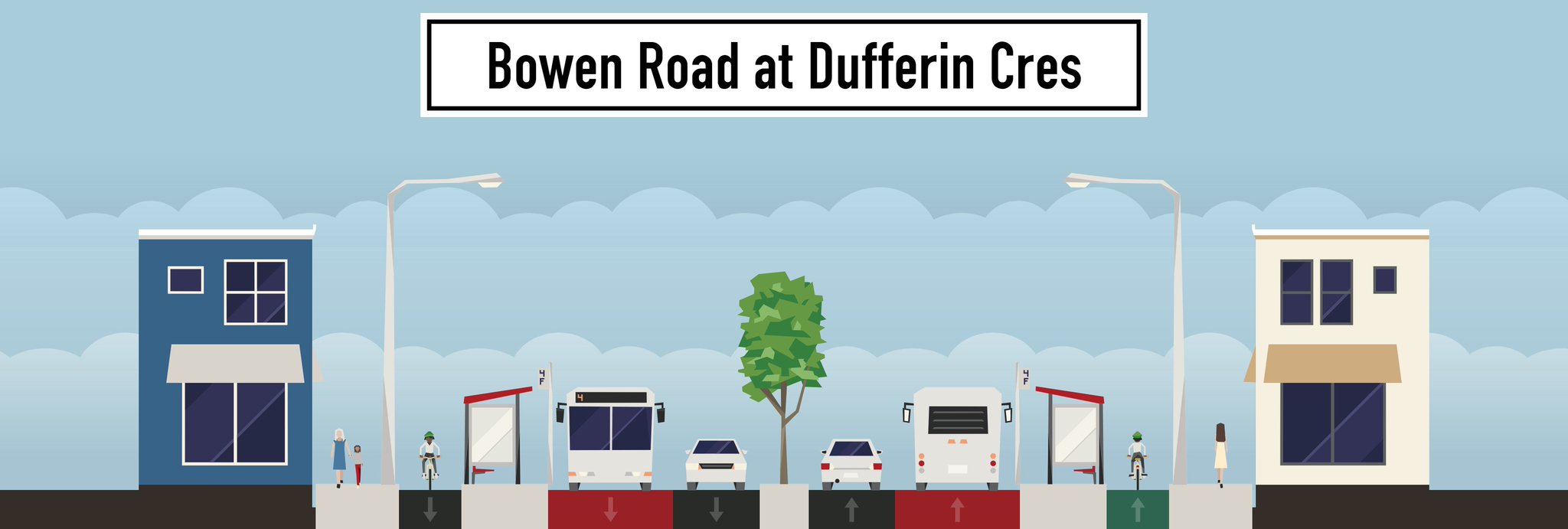
Onstreet parking serves as a buffer between traffic and sidewalk; but there are better ways to do that. We’ve found that any Arterial street, which has segregated auto traffic in the middle and sidewalks along the side, needs some kind of buffer between traffic and sidewalk. If space is an issue, a steel railing has been a common solution. Some kind of vegetation buffer, from grass to bushes to trees, has many advantages. A separated bike lane can serve as a buffer. Opposition to the removal of onstreet parking often includes the sense that some kind of buffer is needed; and this should be accommodated in some way.
April 13, 2014: Arterial Street and Grand Boulevards
Onstreet parking is ugly, and immediately denotes the space as Place for Automobiles, rather than a Place for People. It is, in short, a long, skinny parking lot. And since when is a parking lot a Place For People? A large amount of cars parked on the street can create a strong sense of “automobile congestion” even if there is very little actual moving traffic.
Something about this is not quite right …
Onstreet parking is a terrible form of parking. Parallel parking is no fun for anybody, and many women avoid it altogether. Parallel parking in traffic is worse. Having a lane of moving traffic right alongside, ready to tear your door off, is no fun. Offstreet parking only, please.
Onstreet parking is bad for driving. Drivers must constantly be on the lookout for opening doors, cars pulling in and out and even reversing in traffic while parallel parking, or perhaps children who might step out into the street. Ugh.
Onstreet parking does not provide very much parking. Although the total surface area used for onstreet parking, throughout an entire city, might be rather high, not very many cars can park within a short walk of a destination, such as a store or apartment building. Again, it makes more sense to provide some kind of offstreet solution, because if you actually need a lot of parking, it will have to be offstreet anyway; and why shouldn’t this be market rate? Thus, we find again that onstreet parking only makes sense where it is not needed.
These are all good practical considerations; and they all point toward a policy of no onstreet parking — a policy that might apply well to an existing situation, but especially towards the design of new environments. It is simply a Bad Idea. But, I think I would like to spend more time talking about a kind of entitlement mentality that has built up around free parking. To solve many of our problems today, I think we will have to overtly reject this entitlement mentality.
In the beginning … there was the Traditional City. It looked like this:
San Sebastian, Spain.
There was no need for parking, because there were no cars. There were a few horse-drawn wagons and carriages, mostly used as commercial vehicles, since nobody wants to feed and care for horses, and saddle them up to ride here and there, when they could just walk (at the same speed as a horse walking) instead. You can’t park a horse on the street, except for short periods. Horses were all stored “offstreet,” in stables.
Then, beginning around 1780, we see the rise of Nineteenth Century Hypertrophism. Streets became very, very wide. This was still a hundred years before the automobile. What was the thinking behind these very wide streets? It was a pattern of “rationality” and “science” that engaged societies in general, and was reflected in the Industrial Revolution, the beginnings of Constitutional government, and many other spheres. Existing cities probably had a real need for a small number of very large Grand Boulevards, and a larger number of Arterials, to complement existing Narrow Streets for People. (I generally suggest a ratio of about 3%:17%:80%; or, if you like 1:5:25.) Paris, before the grand boulevards built by Baron Von Haussmann in the 1850s, was probably a pretty difficult place to travel. If you wanted to get across town, and especially if you wanted to get across town with a wagon, it was hard going. It was thus, consequently, an easy place to barricade. The use of barricades in the unrest of the French Revolution, the 1832 June Rebellion, and the Revolution of 1848 led Emperor Napoleon III to instruct Haussmann to make boulevards too wide to be barricaded; and which would also allow the free movement of military troops inside the city.
Wikipedia on Haussman’s Renovation of Paris
Too many Narrow Streets for People? Algeria.
Kowloon Walled City, Hong Kong.
That could get a little oppressive, particularly in the days of coal soot and bad sanitation.
Along with the Narrow Streets of the time came a number of urban pathologies, which people imagined could be solved with wider streets. Air quality was very bad. Streets commonly had horse droppings, possibly raw sewage, and issues with sanitation (uncollected garbage), in addition to issues such as dead animal bodies or people defecating directly in the street. The streets were sewers. Also, this was a time of cooking and heating using wood and coal, creating a constant murk of smoke and soot. Who wouldn’t want a little more fresh air in an environment like that? People had the general impression that this noxious environment also contributed to the spread of infectious disease (probably true, indirectly). Also, wider streets could serve as firebreaks, preventing fires from spreading to large areas. None of these issues are significant today; we still have the habit of very wide streets, but none of the problems that originally inspired them.
It is hard for us to imagine, today, what cities were like. In 1952, “The Great Smog” (combination of fog and coal soot) in London killed an estimated 8,000-12,000 people, including 4000 in the first five days.
All of these factors led to a pattern of Nineteenth Century Hypertrophism, in which the Narrow Street for People disappears, and we get a very wide Arterial-size street as the smallest street type. This was typically laid out on a rigorous grid pattern. While existing European cities like Paris mostly got just a few Grand Boulevards laid upon their older, Traditional City format, this new Nineteenth Century Hypertrophic format was enthusiastically adopted in the United States, where nearly all cities were basically being built from green fields. Expansions of existing European cities (for example, the nineteenth-century portions of Barcelona) also followed this pattern.

Barcelona, Spain. Note the difference between the parts of the city in a Traditional City format with many Narrow Streets for People, and the Nineteenth Century Hypertrophic format, with Arterial-size streets in a grid pattern, plus a few Grand Boulevard-size streets.
These very wide streets were difficult to pave with traditional paving stones. That had to wait until the widespread use of asphalt in the 1920s. They were often a muddy mess. Here is Yonge Street, Toronto:
Danforth Avenue, Toronto:
Naturally, people didn’t want to walk in the mud, so they built sidewalks along the side. This naturally segregated the center of the street for wheeled vehicles.
New York City. Note the depth of the mud and snow, and the sidewalks. The early automobiles had already arrived by the time of this photo.
Toward the end of the nineteenth century, there were more and more wagons, and eventually commercial automobiles such as trucks (personal autos were still to expensive for all but the rich to afford). Naturally, these wagons and motorized trucks would use the side of the road for loading and unloading, but they were rarely parked there overnight. Nevertheless, the basic pattern of stopped vehicles along the side of the road has now emerged.
The Ford Model T, introduced in 1908, lowered the cost of automobiles enough that middle-class families could afford one. By the 1920s, millions of Model Ts had been sold. But, the denser parts of cities, with townhouses and apartment buildings, by then had been designed without any offstreet parking. So, people naturally parked them on the street. At first, who would say no? There still weren’t too many cars. We can see what a huge expanse of underused space those overwide Arterials of Nineteenth Century Hypertrophism presented. With this, the notion of a parking entitlement began to appear.
So we see that the practice of onstreet parking was never intentionally designed. It was a product of the very wide streets of Nineteenth Century Hypertrophism, which had been created for other reasons; the introduction of the automobile over a hundred years later; and the fact that little provision for offstreet parking existed at that time, since cities were not designed for cars. It was a stopgap solution to an unexpected problem.
Like any valuable good given away for free, demand soon outran supply. What happens when everyone in a hundred-unit apartment building wants to own an automobile, and wants to park it on the street? Before long, you can imagine the complaints — we need more parking. (A related parking entitlement was asserted by shopowners, who wanted parking for their customers.)
New York in 1900. Now what happens when all the people living in those apartments decide that they want to park a car on the street?
Now, a good solution here would have been to reduce demand, at the very least by charging for onstreet parking. The city could just set a rate at which perhaps 80% of the available parking was occupied. The problem would have been solved by a reduction in demand via higher pricing rather than an increase in supply. These cities had been designed before automobiles anyway. Nobody needed one.
But the (limited) availability of free onstreet parking created this sense of entitlement. Let’s say that a private developer was thinking about building a multilevel parking lot, and charging perhaps $200 a month for it — the amount necessary to cover his costs of land and construction, and make an adequate profit margin and return on capital. More parking supply. Would this have solved the problem? No, it would just increase the whining. Why do some people get to park on the street for free while I have to pay $200 a month? People would refuse to pay the $200, and the parking lot would lie empty, while people still complained about the shortage of parking.
You even get this when there is free offstreet parking. Why do some people get to park right in front of the restaurant while I have to park 200 meters away in the parking lot? There might be only five onstreet spaces in front of the restaurant, and five hundred in the offstreet lot. But people still seethed with resentment. (This is another good argument for offstreet parking. Make everyone use the offstreet lot.)
Now what was people’s natural reaction to this perceived shortage of parking? They would want to prevent any increase in the number of people in the area, which would threaten their parking entitlement. They become anti-development. Previously, it didn’t matter very much if a new apartment building was added to a street. It would have added a few pedestrians on the sidewalk. Local businesses would get more customers within walking distance of the establishment. People might make new friends. With a larger customer base within walking distance, new businesses could be opened. Now you had a daycare and a dentist right in the neighborhood. There were enough children to build a new school; now they could walk to school. Cities grow denser in part because successful urbanism scales. It gets better and better, with more and more people. Once you introduce personal automobiles, it doesn’t scale anymore. It gets worse and worse, with more and more people. Instead, not only was there a greater shortage of parking, but there was also more traffic, since all those cars don’t sit idle forever. And who was complaining about the traffic? People with cars.
August 28, 2017: Getting Over the Suburban Hump to Successful Urbanism
The response of many city governments was not to eliminate the parking entitlement, and charge a market rate for parking, but rather to relieve the pressure of demand for free onstreet parking by mandating … even more free offstreet parking. Thus we get “parking minimums.” All of these mandated offstreet parking lots naturally used up land that could have been used for buildings and parks, much higher-value uses than automobile storage. And, they would have been used for that, if not for the mandates. That’s why it had to be mandated. This implied, of course, declining density. There was less and less within a square mile of city land — roughly the area within an easy walk. Now you couldn’t get what you needed within walking distance. You had to drive. So you needed a car, or at least, wanted one more. And where would you park?
Even people who didn’t own cars seethed with resentment. I would like to have a car too, but there’s nowhere to park!
Now, let’s see what happens when parking is charged at market rate. There is no entitlement. You have to pay enough that parking outbids the use of that space over all other uses. In other words, you can make more money with a parking lot than from an apartment or office building. Imagine how much that would cost. (We will work out actual numbers later.)
It would cost a lot of money. People would naturally say: “I would like to have a car, but it is way too expensive. Also, I don’t need one. You would have to be a bit of an idiot to waste your money parking a car that you only use three days a month.” The sense of entitlement is gone. With far fewer people that own cars, there is less traffic, and also, less concern about traffic, since only people with cars care about that. Since there are far fewer people that own cars, there is a larger market for all kinds of services aimed at people that don’t own cars, such as regular bus service to destinations outside the city, taxis and delivery services. Locations that can be reached without autos (for example, Coney Island in New York) become more popular. Public transit gets more ridership. To meet increasing demand, buses are replaced by streetcars and then underground subways. More buses and trains run per hour, so wait times are less, transit revenues are higher, and ticket prices can be kept low without subsidy.
But, mostly you should get the cars off the street because it is ugly. Market-rate offstreet parking only, please.
So, here are my recommendations:
1) No onstreet parking in new designs. (There may be something for short-term stops such as deliveries and pickups; but, in lesser-used streets, it is usually possible just to stop in the middle of the street.)
2) Repurpose existing onstreet parking for higher value uses — bike lanes, bus lanes, streetcars, etc.
3) Where there is no obvious higher-value use, and onstreet parking is heavily used, charge a market rate for parking — for example, a monthly pass that reduces demand to less than available supply.
4) Where there is no obvious higher-value use, and onstreet parking isn’t used much, don’t worry about it and just leave it as it is.
5) No mandated subsidies for offstreet parking (parking minimums, etc.).
6) Offstreet parking should be privately-owned/market-rate.
7) Existing offstreet parking may be repurposed to higher-value uses, for example by selling off the land to building developers.
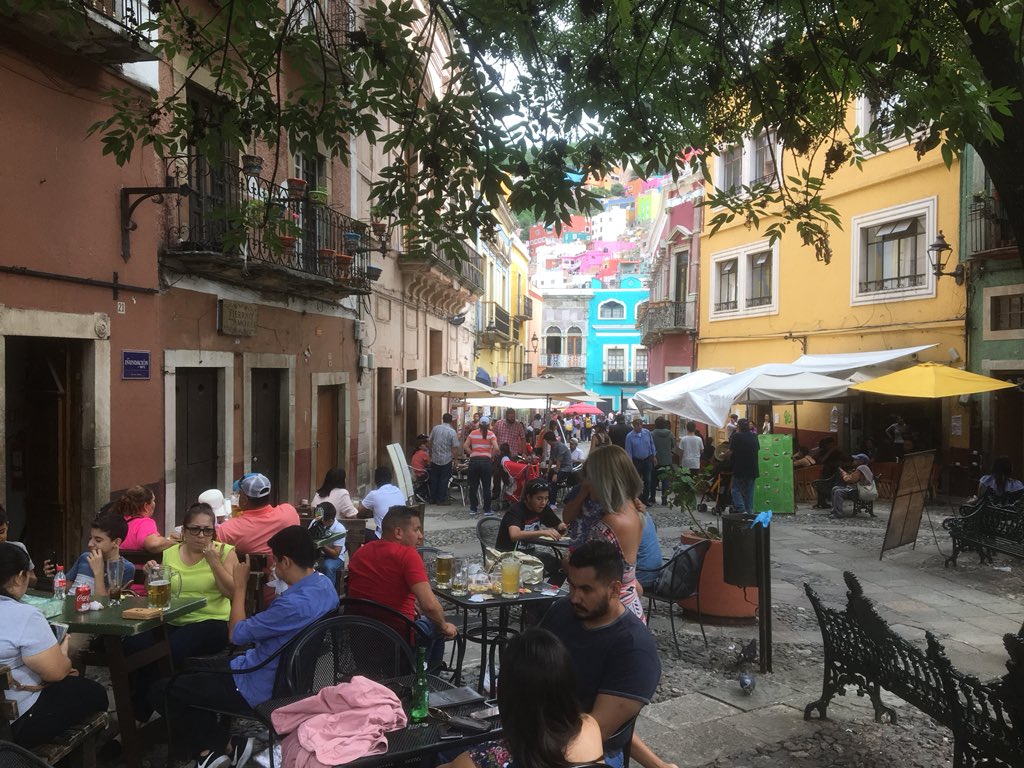
Guanajuato, Mexico. Hasn’t changed much in 500 years. And who would want to change it?
Now that most of the factors (air quality, sanitation etc.) that originally inspired the very wide streets of Nineteenth Century Hypertrophism are passed, it is time to return to the Traditional City format that was common throughout the world before 1800.
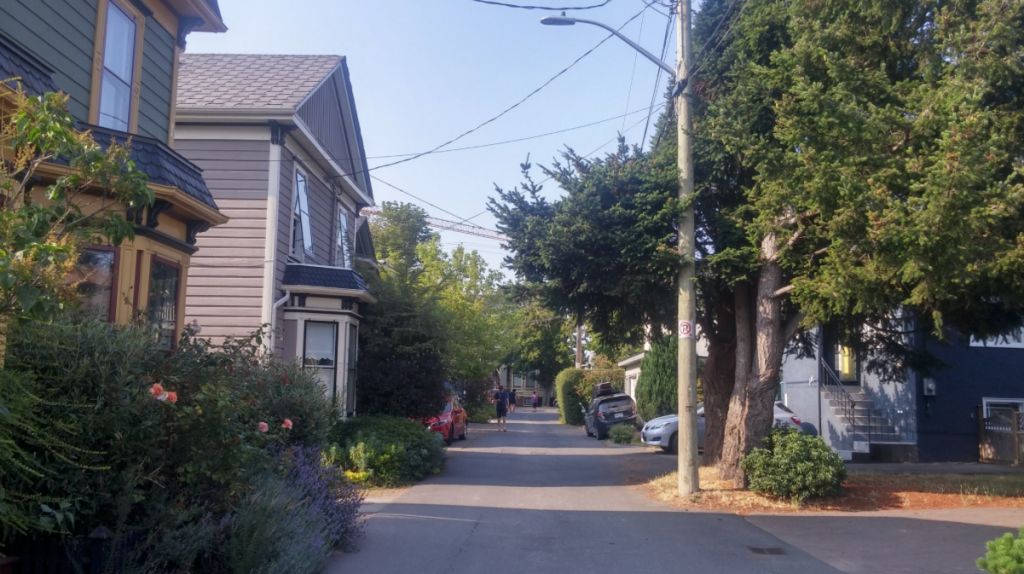
This residential street is about twelve feet wide. But, there is plenty of offstreet parking. Doesn’t that seem like a safer, quieter, prettier, more child-friendly environment? It also uses far less space, which reduces infrastructure costs.
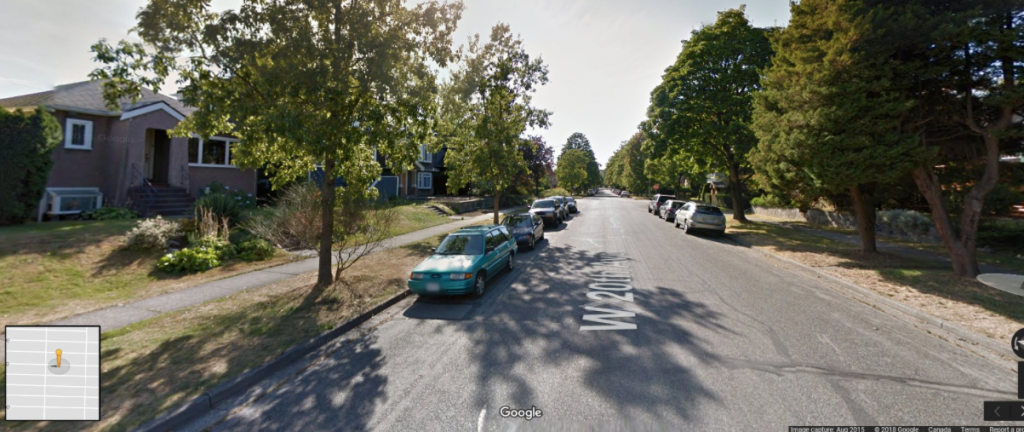
This residential street has the capacity for a practically unlimited amount of offstreet parking. Plus, the long-term costs of maintaining all of that pavement is considerable, especially compared to the property tax revenues from the small number of buildings along this street.
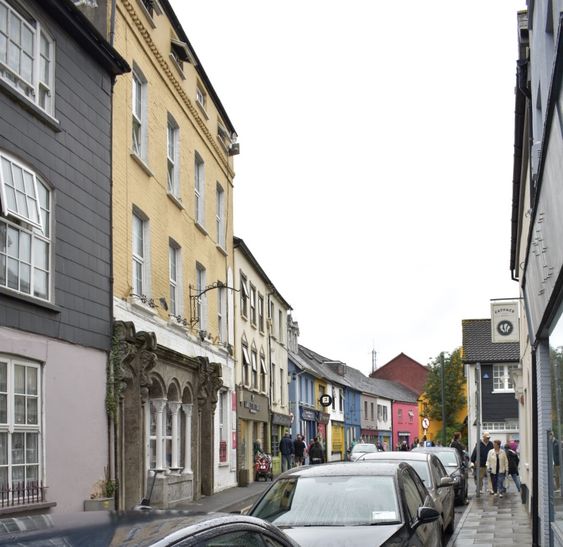
You don’t have to ban cars from streets like this, but you should ban onstreet parking. At the end of the day, it doesn’t even provide very much parking.

What a waste. And look at all that offstreet open space just down the hill.
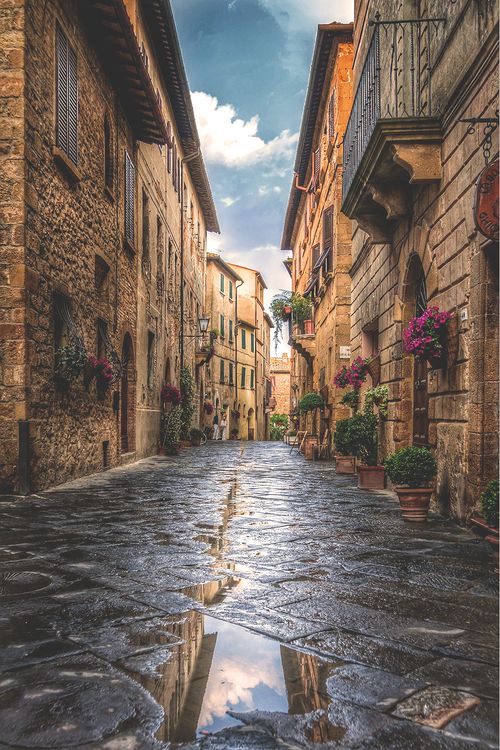
More like this, please.
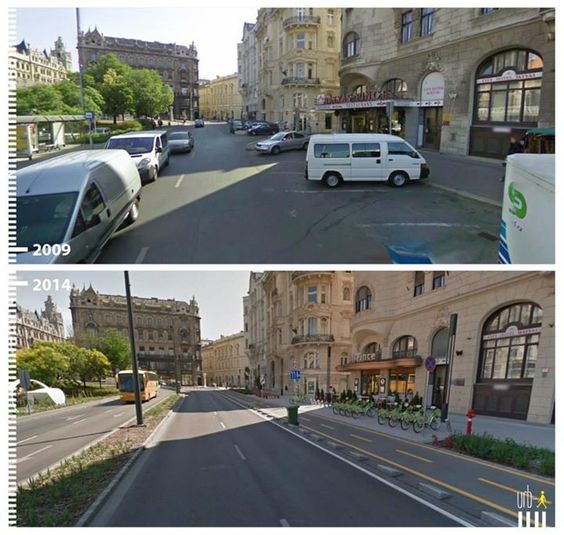
On a busy Arterial, the elimination of onstreet parking can allow the introduction of dedicated bus and bike lanes, and dedicated left turn lanes — all of which reduces traffic (because more people are using buses and bikes), makes auto alternatives more appealing (because bikes and buses have their own dedicated lanes) and also, makes remaining vehicle traffic move more smoothly, due to dedicated left turn lanes and no obstructions from parked cars.


